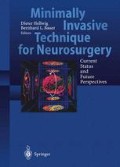Summary
The technical advantages of the MKM neuronavigation system from Zeiss were tested during cadaveric dissections of the petrous bone. The optical probe, contours and plans which are projected directly on the microscope field enhanced orientation and provided accurate anatomical monitoring of the dissections. These features need practice and understanding of some factors and must be considered advantageous in the performance of petrous bone surgery.
Access this chapter
Tax calculation will be finalised at checkout
Purchases are for personal use only
Preview
Unable to display preview. Download preview PDF.
References
Anson BJ, Donaldson JA (1981) Surgical anatomy of the temporal bone, 3rd edn. Saunders Philadelphia
Chakeres DW, Spiegel PK (1983) A sytematic technique for comprehensive evaluation of the temporal bone by computed tomography. Radiology 146: 97–106
Domb GH, Chole RA (1980) Anatomical studies of the posterior petrous apex with regard to hearing preservation in acoustic neuroma removal Laryngoscope 9o:1769–1776
El Azm M, Samii M, Bini W (1988) Computed tomographic studies in acoustic neurinomas in relation to the vestibular organ and hearing function. In: Frayse B, Lazorthes Y (eds) Neurinomes de l’Acoustique. Fabre, pp 81–89
Friets E, Struhbehn JW, Hatch JF, Roberts DW (1989) A frameless stereotaxic operation microscope for neurosurgery. IEEE Trend Act Bio Eng 36(6): 608–617
Kaminsky J, Arango G, Brinker T, Samii M (1997) Requirements for referencing of the MKM neuronavigation system. Minimal Invasive Technique for Neurosurgery, ed. Hellwig, Bauer, Springer-Verlag (1998)
Galloway RL, Maciunas RJ, Edwards CE (1992) Interactive image-guided neurosurgery. IEEE Trend Act Bio Eng 39 (12):1226–1231
Golfinos JG, Fitzpatrick BC, Smith LR, Spetzler RF (1995) Clinical use of a frameless stereotactic arm: results of 325 cases. J Neurosurg 83:197–205
Maciunas RG, Galloway RL, Latimer JW (1994) Application accuracy of stereotactic frames. Neurosurgery 35: 682–695
Matula C, Diaz-Day J, Czech T, Koos WT (1995) The retrosigmoid approach to acoustic neurinomas: technical, strategic, and future concepts. Acta Neurochir (Wien) 134(3–4)139–147
Nabavi A, Manthei G, Blömer U (1995) Neuronavigation: Computergestütztes operieren in der Neurochirurgie. Radiologe 35:573–577
Pellet W, Cannoni M, Pech A (1990) Oto-neurosurgery. Springer, Berlin Heidelberg New York, pp 5–40
Samii M, Matthies C, Tatagiba M (1991) Intracanalicular acoustic neurinomas. Neurosurgery 29:189–199
Tatagiba M, Samii M, Matthies C, El Azm M, Schönmayr R (1992) The significance for postoperative hearing of preserving the labyrinth in acoustic neurinoma surgery. J Neurosurg 77: 677–684
Ungersböck K, Rossler K, Matula C, Koos WT (1996) Rahmenlose Stereotaxie: klinische Erfahrungen mit dem stereotaktisch geführten Operationsmikroskop MKM und dem Neuronavigationssystem Easy guide. Zentralbl Neurochir [Suppl]: 16–17
Watanabe E, Watanabe T, Manaka S, Mayanagi Y, Takakura K (1987) Three dimentional digitizer “Neuronavigator”: new equipment for computed tomography-guided stereotaxic surgery. Surg Neurol 27:543–547
Editor information
Editors and Affiliations
Rights and permissions
Copyright information
© 1998 Springer-Verlag Berlin Heidelberg
About this paper
Cite this paper
Arango, G., Kaminsky, J., Brinker, T., Thorns, U., Samii, M. (1998). Neuronavigation to the Petrous Bone: A Cadaveric Study. In: Hellwig, D., Bauer, B.L. (eds) Minimally Invasive Techniques for Neurosurgery. Springer, Berlin, Heidelberg. https://doi.org/10.1007/978-3-642-58731-3_35
Download citation
DOI: https://doi.org/10.1007/978-3-642-58731-3_35
Publisher Name: Springer, Berlin, Heidelberg
Print ISBN: 978-3-642-63701-8
Online ISBN: 978-3-642-58731-3
eBook Packages: Springer Book Archive

